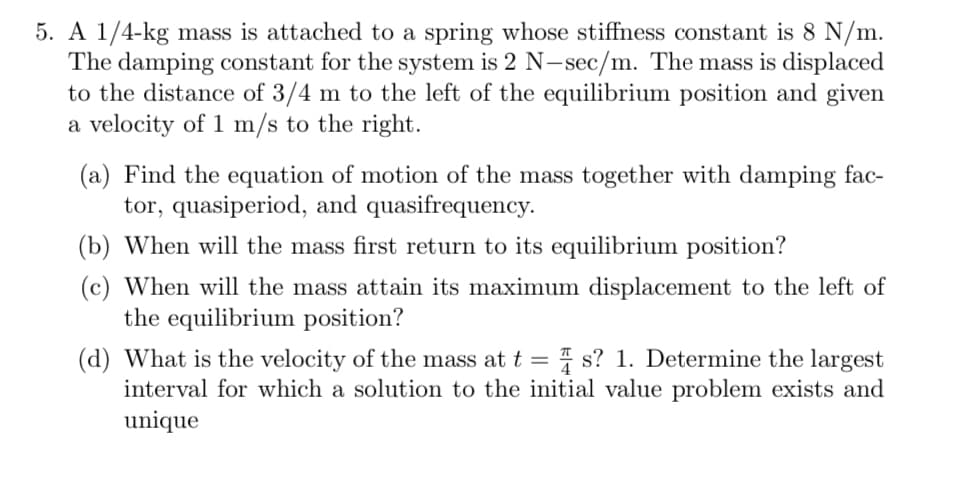5. A 1/4-kg mass is attached to a spring whose stiffness constant is 8 N/m. The damping constant for the system is 2 N-sec/m. The mass is displaced to the distance of 3/4 m to the left of the equilibrium position and given a velocity of 1 m/s to the right. (a) Find the equation of motion of the mass together with damping fac- tor, quasiperiod, and quasifrequency. (b) When will the mass first return to its equilibrium position? (c) When will the mass attain its maximum displacement to the left of the equilibrium position? (d) What is the velocity of the mass at t = s? 1. Determine the largest interval for which a solution to the initial value problem exists and unique
5. A 1/4-kg mass is attached to a spring whose stiffness constant is 8 N/m. The damping constant for the system is 2 N-sec/m. The mass is displaced to the distance of 3/4 m to the left of the equilibrium position and given a velocity of 1 m/s to the right. (a) Find the equation of motion of the mass together with damping fac- tor, quasiperiod, and quasifrequency. (b) When will the mass first return to its equilibrium position? (c) When will the mass attain its maximum displacement to the left of the equilibrium position? (d) What is the velocity of the mass at t = s? 1. Determine the largest interval for which a solution to the initial value problem exists and unique
Advanced Engineering Mathematics
10th Edition
ISBN:9780470458365
Author:Erwin Kreyszig
Publisher:Erwin Kreyszig
Chapter2: Second-order Linear Odes
Section: Chapter Questions
Problem 1RQ
Related questions
Question

Transcribed Image Text:5. A 1/4-kg mass is attached to a spring whose stiffness constant is 8 N/m.
The damping constant for the system is 2 N-sec/m. The mass is displaced
to the distance of 3/4 m to the left of the equilibrium position and given
a velocity of 1 m/s to the right.
(a) Find the equation of motion of the mass together with damping fac-
tor, quasiperiod, and quasifrequency.
(b) When will the mass first return to its equilibrium position?
(c) When will the mass attain its maximum displacement to the left of
the equilibrium position?
(d) What is the velocity of the mass at t = s? 1. Determine the largest
interval for which a solution to the initial value problem exists and
unique
Expert Solution
This question has been solved!
Explore an expertly crafted, step-by-step solution for a thorough understanding of key concepts.
This is a popular solution!
Trending now
This is a popular solution!
Step by step
Solved in 3 steps with 3 images

Recommended textbooks for you

Advanced Engineering Mathematics
Advanced Math
ISBN:
9780470458365
Author:
Erwin Kreyszig
Publisher:
Wiley, John & Sons, Incorporated

Numerical Methods for Engineers
Advanced Math
ISBN:
9780073397924
Author:
Steven C. Chapra Dr., Raymond P. Canale
Publisher:
McGraw-Hill Education

Introductory Mathematics for Engineering Applicat…
Advanced Math
ISBN:
9781118141809
Author:
Nathan Klingbeil
Publisher:
WILEY

Advanced Engineering Mathematics
Advanced Math
ISBN:
9780470458365
Author:
Erwin Kreyszig
Publisher:
Wiley, John & Sons, Incorporated

Numerical Methods for Engineers
Advanced Math
ISBN:
9780073397924
Author:
Steven C. Chapra Dr., Raymond P. Canale
Publisher:
McGraw-Hill Education

Introductory Mathematics for Engineering Applicat…
Advanced Math
ISBN:
9781118141809
Author:
Nathan Klingbeil
Publisher:
WILEY

Mathematics For Machine Technology
Advanced Math
ISBN:
9781337798310
Author:
Peterson, John.
Publisher:
Cengage Learning,

